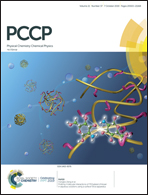Probing the functional conformations of an atypical proline-rich fusion peptide†
Abstract
The left-handed polyproline II (PPII) type helical structures are thought to play a very important role in many essential biological processes, particularly in recognition mechanisms. However, reliable characterisation of PPII conformation in solution can be experimentally challenging. Computational simulation of these structures offers an attractive alternative, but the accuracy of the results is dependent on the accuracy of the force field employed. In this report, we present the results of simulation of the structural and dynamical properties of a proline-rich viral fusion peptide for which a solution NMR study reported a substantial stretch of PPII conformation in the central region. The suggested mode of action of the p15 fusion peptide depended on the exposure of the flanking N-terminal hydrophobic residues to solvent thereby facilitating their interaction with the target membrane. Our simulations with a set of four force field and water model combinations consisting of (AMBER ff99SB*-ILDNP + TIP3P), (OPLS-AA + SPC/E), (AMBER ff03ws + TIP4P/2005 water with scaled protein–water interactions) and (CHARMM36m + TIP3P) showed a general agreement with the NMR results for all the four force field and water model combinations. The central region encompassing positions 9–15 showed a large PPII propensity, reduced flexibility and lower conformational entropy. The PPII conformations were stable and satisfied the Burgi–Dunitz criteria without the participation of any significant water bridging interaction. However, comparison of the experimentally observed chemical shifts with the distribution of shifts predicted from the simulated ensembles showed a much better agreement for the CHARMM36m + TIP3P and AMBER ff03ws + TIP4P/2005 combinations. The models based on these two force fields also generated conformations which were in much better agreement with the NMR model than the much more compact structures predicted by the AMBER ff99SB*-ILDNP and OPLS-AA force fields and predicted a substantially larger solvent accessible surface area in accordance with the suggested mechanism of action of the peptide.



 Please wait while we load your content...
Please wait while we load your content...